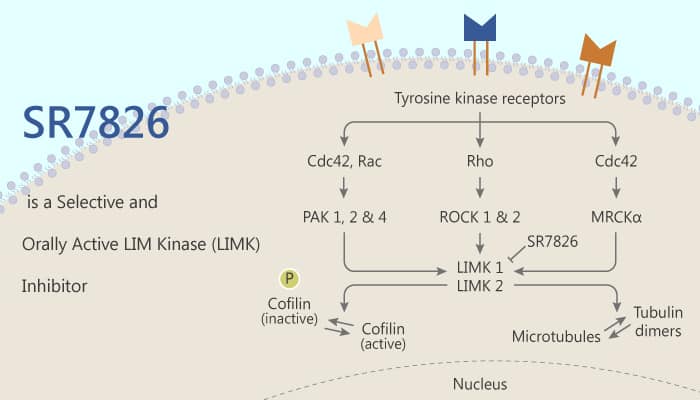LIM-kinase (Limk) is a serine-threonine protein kinase. Two isoforms are LIM kinase 1 (Limk1) and LIM kinase 2 (Limk2). Limk1 is overexpressed in cancerous prostate cells and tissues. Previous studies shows that the possibility of up-regulated Limk1 as a cellular oncogene and inhibition of Limk1 activity in cancerous prostate cells and tissues could lead to a reduction of phosphorylated cofilin and decrease of the cells’ motility, thus the invasiveness of tumor cells and their evolution to metastasis. Therefore, small-molecule inhibitors of Limk1 could be potential therapeutic agents for prostate cancers. In addition, Limk inhibitors may have high potentials as therapeutics in anti-HIV infection applications. In this study, SR7826 is a potent, selective, and orally active LIM kinase (LIMK) inhibitor, with an IC50 of 43 nM for LIMK1. It displays >100-fold more selective for LIMK1 than ROCK and JNK kinases.

In the profiling against a panel of 61 kinases, SR7826 at 1 μM inhibits only Limk1 and STK16 with ≥80% inhibition. SR7826 is highly efficient in inhibiting cell invasion/migration in PC-3 cells. Furthermore, SR7826 (compound 18b) inhibits cofilin phosphorylation in A7r5 (IC50 = 470 nM) and PC-3 cells (IC50<1 µM). SR7826 treatment significantly reduces the phosphorylation of cofilin at Ser3. SR7826 also increases both apical and basal thin spine density significantly in hAPPJ20 mice over mock-treated animals.
In summary, SR7826 at 1 μM inhibits only Limk1 and STK16 with ≥ 80% inhibition. It is also highly efficient in inhibiting cell invasion/migration in PC-3 cells. In addition, therapeutically targeting LIMK1 may provide dendritic spine resilience to Aβ. Therefore, it may benefit cognitively normal patients that are at high risk for developing dementia.
Reference:
Yan Yin, et al. J Med Chem. 2015 Feb 26;58(4):1846-61.; Benjamin W Henderson, et al. Sci Signal. 2019 Jun 25;12(587):eaaw9318.